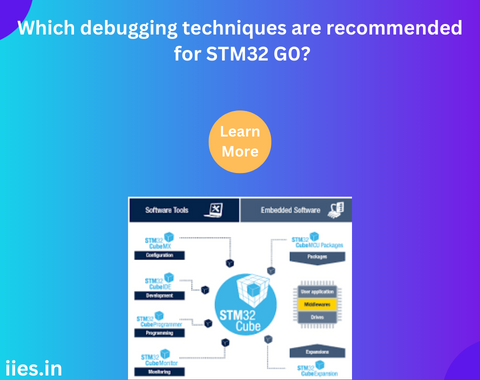
Debugging is an integral part of embedded systems development, especially when working with microcontrollers like the STM32 G0 series. These microcontrollers offer powerful features but debugging can be challenging due to the limited resources and real-time constraints. However, with the right techniques and tools, developers can efficiently identify and resolve issues in their STM32 G0 projects. In this article, we will explore some recommended debugging techniques tailored for STM32 G0 microcontrollers.
1. Serial Output Debugging:
Serial output debugging is a fundamental technique for debugging STM32 G0 microcontrollers. By printing debug information over a serial interface (UART), developers can monitor variables, function outputs, and program flow in real-time. This technique is lightweight and doesn’t require additional hardware, making it ideal for early-stage debugging. To utilize serial output debugging: – Configure a UART peripheral on the STM32 G0 microcontroller. – Use printf or custom debug functions to print debug messages. – Monitor the serial output using a terminal emulator like PuTTY or Tera Term.
2. LED Indication:
LEDs are commonly available on development boards and can be used as visual indicators for debugging purposes. By toggling LEDs at various points in the code, developers can track program execution and identify issues related to loops, conditions, or function calls. This technique is straightforward and provides immediate feedback without the need for extra hardware. To implement LED indication debugging: – Assign specific LEDs to different program states or conditions. – Toggle LEDs using GPIO pins within the code. – Observe LED behavior to understand program flow and detect anomalies.
3. Breakpoints and Watchpoints:
Integrated Development Environments (IDEs) like STM32CubeIDE provide advanced debugging features such as breakpoints and watchpoints. Breakpoints allow developers to pause program execution at specific lines of code, enabling them to inspect variable values and step through the code interactively. Watchpoints, on the other hand, trigger breakpoints when a specific memory location is accessed, making them useful for detecting unexpected changes. To leverage breakpoints and watchpoints effectively: – Set breakpoints at critical points in the code where issues are suspected. – Define watchpoints for variables or memory locations of interest. – Use the debug perspective in the IDE to analyze program behavior during runtime.
4. Real-Time Debugging with SWO:
Serial Wire Output (SWO) is a debug interface available on STM32 microcontrollers, including the G0 series. SWO enables real-time debugging by streaming debug information, such as variable values and trace data, through a single pin interface. This technique is highly efficient and allows developers to monitor system behavior without impacting program execution significantly. To enable real-time debugging with SWO: – Configure the SWO pin and enable SWO trace output in the microcontroller’s debug configuration. – Instrument the code with trace statements or use trace macros provided by the IDE. – Use a debugger probe compatible with SWO, such as ST-LINK, to capture and analyze trace data.
5. Hardware Debugging with JTAG/SWD:
For complex debugging scenarios or issues that cannot be resolved using software-based techniques, hardware debugging with Joint Test Action Group (JTAG) or Serial Wire Debug (SWD) interfaces is indispensable. These interfaces provide direct access to the microcontroller’s core and memory, allowing developers to inspect registers, memory contents, and peripherals in real-time. To perform hardware debugging with JTAG/SWD: – Connect a debugger probe, such as ST-LINK, to the microcontroller’s JTAG or SWD pins. – Use an IDE with hardware debugging support to connect to the target and control the debugging session. – Utilize features like memory viewing, register inspection, and peripheral debugging to diagnose complex issues.
6. RTOS-aware Debugging:
When working with real-time operating systems (RTOS) on STM32 G0 microcontrollers, traditional debugging techniques may not provide sufficient insight into task scheduling, resource conflicts, and timing issues. RTOS-aware debugging tools, such as SEGGER SystemView or Percepio Tracealyzer, offer deep visibility into RTOS internals, allowing developers to analyze task execution, interrupts, and resource utilization in real-time. To leverage RTOS-aware debugging: Integrate RTOS-aware debug agents into the firmware. Configure the debug agent to capture task scheduling events, semaphore usage, and interrupt activity. Analyze the captured data using visualization tools to identify timing anomalies and optimize task execution.
7. Power Consumption Profiling:
Optimizing power consumption is crucial for battery-powered STM32 G0 applications. Debugging power-related issues requires tools and techniques to measure and profile power consumption accurately. Advanced debugging probes, such as ST-LINK Power Measurement Kit or external power analyzers, provide real-time power consumption data, enabling developers to identify inefficient code patterns, optimize sleep modes, and minimize energy usage. To profile power consumption: Connect the power measurement tool between the power source and the microcontroller. Instrument the firmware to trigger power measurement events during specific operations or conditions. Analyze the power consumption data to identify energy-hungry code segments and implement power-saving optimizations.
Debugging STM32 G0 microcontroller projects requires a combination of techniques tailored to the specific constraints and requirements of embedded systems development. By leveraging serial output debugging, LED indication, breakpoints, watchpoints, real-time debugging with SWO, and hardware debugging with JTAG/SWD, developers can effectively identify and resolve issues at various stages of the development process. Choosing the right debugging technique depends on factors such as the complexity of the project, available resources, and desired level of insight into the system behavior. With these recommended techniques, developers can streamline the debugging process and ensure the reliability and performance of their STM32 G0-based applications.
Indian Institute of Embedded Systems – IIES